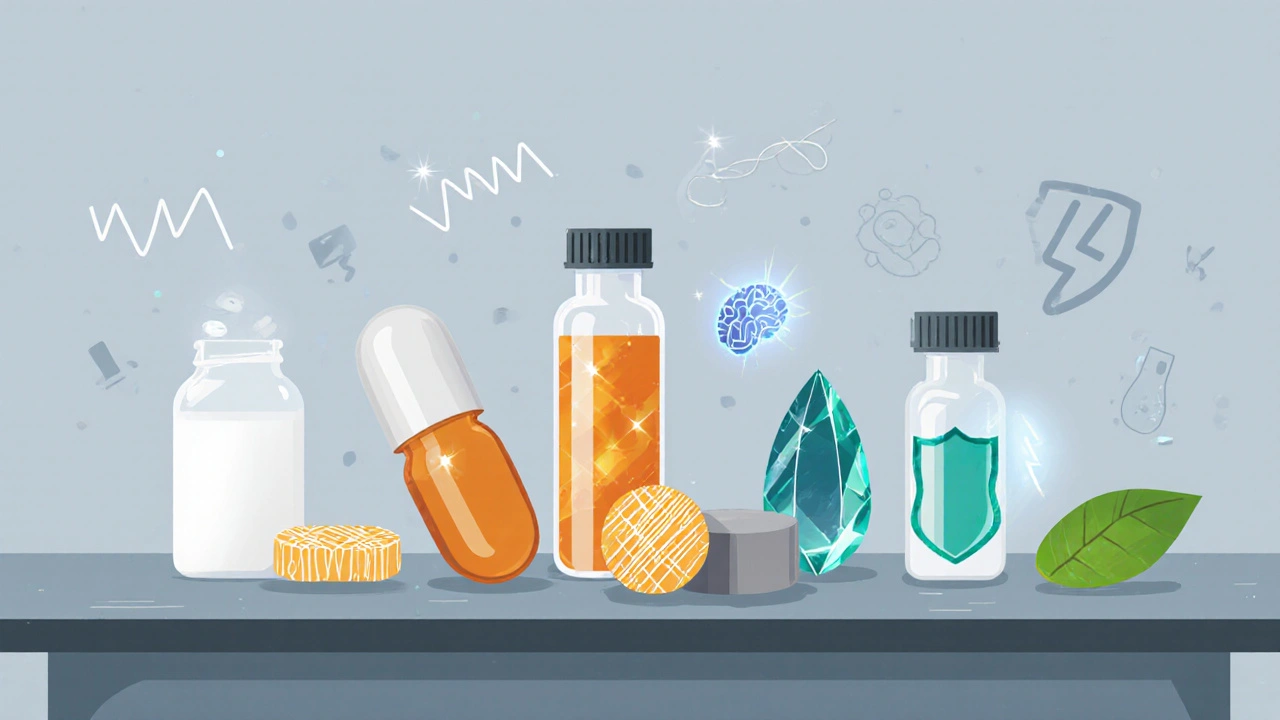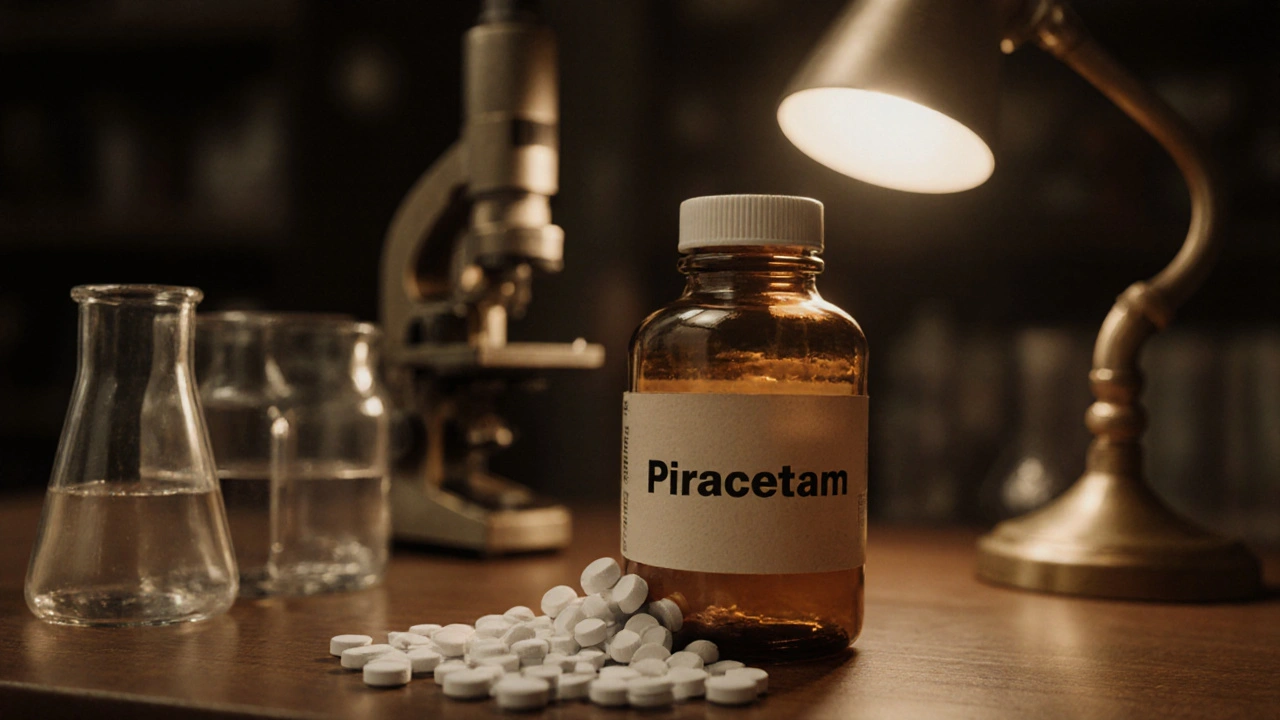Nootropil vs Alternatives Decision Guide
Key Takeaways
- Nootropil (Piracetam) is the oldest synthetic nootropic, praised for safety but modest potency.
- Modern alternatives like Aniracetam and Noopept often deliver faster onset and stronger effects.
- Choose based on desired outcome: memory boost, mood enhancement, or synergistic stacking.
- All compounds share similar safety profiles when used at recommended doses, but drug interactions vary.
- Legal status in the UK and EU differs; most are prescription‑only, while some are sold as research chemicals.
When you hear the name Nootropil (Piracetam), the image that often pops up is a decades‑old “smart pill” that improves memory without a high hype. But the nootropic market has exploded, and newer molecules promise sharper focus, better mood, or even neuro‑protection. This guide breaks down how Nootropil stacks up against the most popular alternatives, so you can pick the right brain boost for your goals.
We’ll walk through the science, typical dosing, onset times, evidence strength, side‑effect risk, and practical use‑cases for each option. By the end you’ll know whether the classic Nootropil still fits your needs or if a newer contender is a better match.
What Is Nootropil (Piracetam)?
Piracetam is the first‑generation racetam, discovered in the 1960s by Dr. Corneliu E. Giurgea. It belongs to the broader class of “nootropics,” substances that aim to enhance cognition without major side effects. In the UK, Piracetam is classified as a prescription‑only medicine, typically used for age‑related cognitive decline or dyslexia.
How Piracetam Works
The exact mechanism isn’t fully nailed down, but three actions are widely accepted:
- Improves neuronal membrane fluidity, which helps signal transmission.
- Modulates the AMPA‑type glutamate receptors, enhancing synaptic plasticity.
- Increases blood flow and oxygen utilization in the brain.
These effects translate into modest gains in memory retention and learning speed, especially when paired with a solid diet and regular exercise.

Top Alternatives Overview
Below are the most talked‑about rivals, each with a distinct profile.
Aniracetam is a more potent racetam that also influences the serotonin and dopamine systems, giving it a mild anxiolytic feel.
Oxiracetam leans toward stimulation, boosting alertness and logical thinking.
Pramiracetam is designed for high‑dose memory enhancement, often used by students during intensive study periods.
Noopept is a peptide‑like molecule that is up to 1000 times more potent than Piracetam in animal models, with reported neuroprotective benefits.
Alpha‑GPC supplies choline directly to the brain, supporting acetylcholine production-a key neurotransmitter for memory.
L‑Theanine is an amino acid found in tea that promotes calm focus by increasing alpha‑brain waves.
Side‑by‑Side Comparison
| Compound | Primary Mechanism | Typical Dose | Onset | Duration | Evidence Strength | Common Side Effects | Best Use‑Case |
|---|---|---|---|---|---|---|---|
| Piracetam | Membrane fluidity, AMPA modulation | 1.2-4.8g/day (split) | 30-60min | 4-6h | Moderate - 40+ clinical trials | Headache, insomnia (rare) | General memory support, age‑related decline |
| Aniracetam | Racemic, modulates AMPA + serotonin | 750mg-1.5g/day (with choline) | 15-30min | 2-3h | Moderate - some RCTs show mood benefit | Headache, mild anxiety | Creative work, anxiety‑related focus |
| Oxiracetam | Stimulatory racetam, NMDA interaction | 800mg-2g/day | 20-40min | 3-4h | Low‑Moderate - anecdotal, few studies | Insomnia, jitteriness | Logic‑heavy tasks, study marathons |
| Pramiracetam | High‑affinity choline uptake enhancer | 300-900mg/day | 30-45min | 5-8h | Low - limited human data | Headache, rare GI upset | Intensive exam prep, high‑load memory |
| Noopept | Peptide‑like, neurotrophic factor up‑regulation | 10-30mg/day | 5-15min | 2-3h | Emerging - promising animal data, few human trials | Headache, rare skin rash | Neuro‑protection, rapid cognition boost |
| Alpha‑GPC | Choline donor, boosts acetylcholine | 300-600mg/day | 15-30min | 4-6h | Strong - multiple RCTs on memory | Heartburn, mild dizziness | Synergy with racetams, age‑related decline |
| L‑Theanine | Increases alpha‑wave activity, GABA modulation | 100-200mg (often with caffeine) | 5-10min | 6-8h | Strong - robust clinical data for stress reduction | None significant | Calm focus, anxiety reduction |
Pros and Cons of Piracetam vs Each Alternative
Piracetam shines in safety: decades of use mean doctors are comfortable with its tolerability. However, its potency is the lowest among the racetams, often requiring gram‑scale doses for noticeable effects.
- Against Aniracetam: Aniracetam feels smoother and works faster, but you usually need a choline source to avoid headaches.
- Against Oxiracetam: Oxiracetam delivers a clear stimulant edge, useful for long study sessions, whereas Piracetam can feel “flat” for some.
- Against Pramiracetam: Pramiracetam’s higher affinity for cholinergic receptors can produce stronger memory gains at lower milligram doses.
- Against Noopept: Noopept’s rapid onset (minutes) and neuroprotective claims make it attractive for users wanting quick results.
- Against Alpha‑GPC: Alpha‑GPC isn’t a racetam; it supplies the building blocks Piracetam relies on, often used together for synergistic effect.
- Against L‑Theanine: Theanine offers calm focus without any prescription hurdle, perfect for people sensitive to the slight jitter Piracetam can sometimes cause.
Safety, Interactions, and Legal Status
All compounds listed are generally well tolerated at recommended doses, but a few caveats are worth noting:
- Choline depletion: racetams (Piracetam, Aniracetam, Oxiracetam, Pramiracetam) can boost acetylcholine usage, leading to headaches if you don’t supplement with a choline source (Alpha‑GPC, CDP‑Choline).
- Blood‑thinners: high‑dose Piracetam may modestly affect platelet aggregation; consult a doctor if you’re on warfarin.
- Pregnancy & breastfeeding: none of these are approved; safest route is to avoid.
- Legal notes: In the UK, Piracetam, Aniracetam, Oxiracetam, Pramiracetam, and Noopept are prescription‑only. Alpha‑GPC and L‑Theanine are sold as foods/supplements.
Choosing the Right Cognitive Enhancer
Here’s a quick decision tree you can use:
- If you need a gentle, well‑studied starter and don’t mind daily gram‑scale doses → Piracetam.
- If you want faster mood lift + anxiety reduction → Aniracetam + choline.
- If you crave stimulant‑type focus for intense problem‑solving → Oxiracetam.
- If you’re preparing for high‑volume memorization and can handle milligram dosing → Pramiracetam.
- If you seek rapid, potent boost with neuro‑protective claims → Noopept (watch for skin reactions).
- If you already use a racetam and want to support acetylcholine → Alpha‑GPC or CDP‑Choline.
- If you prefer non‑prescription, calm focus and often drink coffee → L‑Theanine.
Many experienced users stack a racetam with a choline donor and L‑Theanine to smooth the edge. Start low, monitor how you feel, and always keep a log of dose, timing, and subjective effects.
Frequently Asked Questions
Can I take Piracetam without a prescription in the UK?
Legally, Piracetam is a prescription‑only medicine in the UK, so you need a doctor's approval. Some online vendors sell it as a “research chemical,” but that skirts the law and carries risk.
Do I need a choline supplement with Piracetam?
It’s not mandatory, but many users experience headaches when acetylcholine stores run low. Adding 250-500mg of Alpha‑GPC or CDP‑Choline usually prevents that.
How does Noopept compare to Piracetam in terms of safety?
Both have good safety records at recommended doses, but Noopept is more potent, so the margin for overdose is narrower. Reported side effects are similar (headache, mild nausea), though rare skin reactions have been noted.
Can I stack multiple racetams together?
Stacking is possible but not common. Mixing Piracetam with Aniracetam can increase cholinergic demand, leading to stronger headaches if you don’t boost choline. Most users pick one primary racetam and add a choline source and maybe L‑Theanine for smoothness.
What’s the best time of day to take Piracetam?
Because its effects last 4-6hours, many split the total daily dose into two or three servings: one in the morning, one after lunch, and optionally one early evening. Avoid late‑night dosing if you’re sensitive to sleep disruption.




